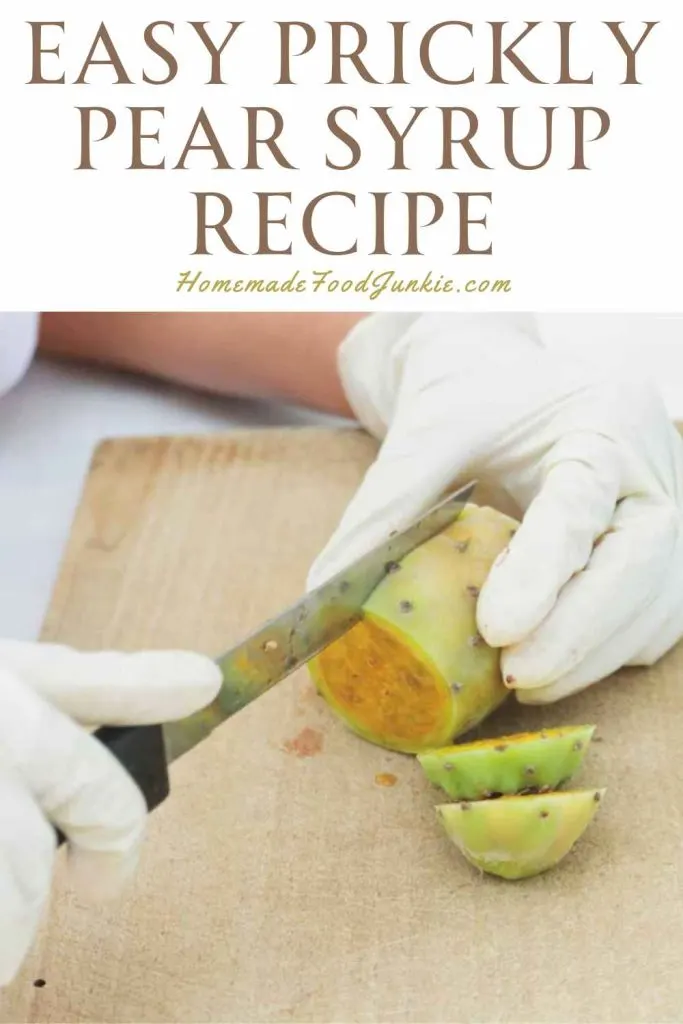Prickly pear syrup is a delicious by-product of the prickly pear cactus. You can easily make it yourself with our simple prickly pear syrup recipe. The fruits are boiled down, strained and made into a lovely syrup with many uses in the kitchen.
What is cactus syrup used for? Cactus syrup is often used as a topping or sweetener over desserts or in recipes. Cactus syrup is yummy drizzled over pancakes, waffles, or desserts. It’s also a good addition to cocktails or mocktails where it infuses the drink with it’s own unique flavor. Make it a glaze for meats or vegetables, or incorporate cactus syrup into sauces, dressings, and baked goods.
Its distinct taste and vibrant color add a touch of sweetness and an exotic twist to a wide range of dishes. Be creative with it. Prickly pear syrup has a subtly tropical flavor. The taste is reminiscent of a combination of watermelon, melon, pear, and bubblegum, but with its own distinctly tangy character. You have to try it!
What is Prickly Pear Syrup Made Of? Prickly pear syrup is made from the juice extracted from prickly pear cactus fruits, also known as tunas. To sweeten the syrup, sugar or another sweetener is added to balance the natural tartness of the fruit. Some recipes may also add in lemon juice or spices to enhance the flavor profile.
This delightful and refreshing syrup adds a touch of the exotic to various culinary creations. Enjoy the unique flavor and vibrant color of homemade prickly pear syrup in your favorite recipes. Or create new dishes to impress your family.
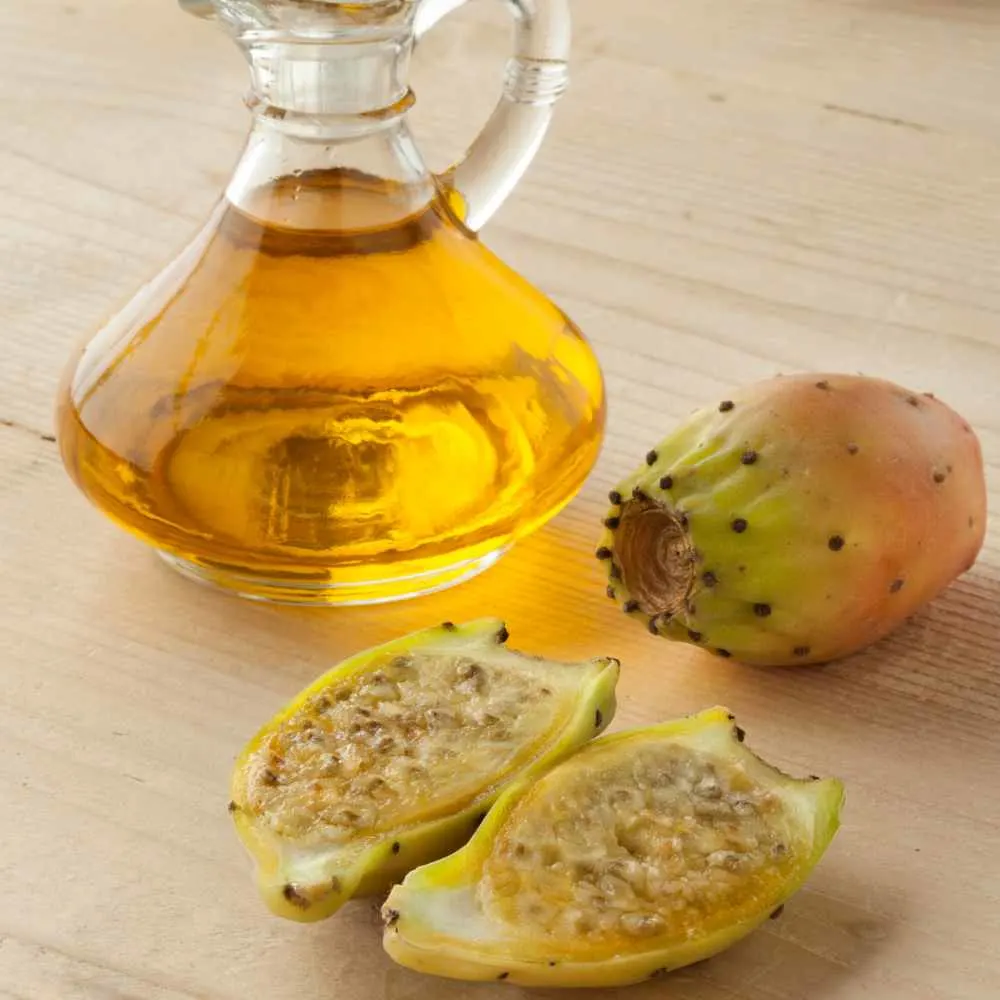
Is Prickly Pear Cactus Juice Good For You?
Yes, Prickly pear cactus juice is not only delicious, it has a good number of health benefits. The juice is full of nutrients and antioxidants and there are even more reasons to add it to your diet. Let’s go deeper…
- Nutritional content: Prickly pear cactus juice is rich in vitamins, minerals, and antioxidants. It contains significant amounts of vitamin C, vitamin B6, vitamin E, magnesium, potassium, and calcium, among others. These nutrients are essential for supporting overall health and well-being.
- Hydration: Prickly pear juice has a high water content, which can help hydrate the body. Staying hydrated is important for various bodily functions and can contribute to better skin health, digestion, and overall cellular function.
- Antioxidant properties: Prickly pear cactus juice contains antioxidants that help combat oxidative stress and free radicals in the body. Antioxidants play a role in reducing inflammation, supporting the immune system, and protecting against chronic diseases.
- Potential blood sugar management: Some studies suggest that prickly pear cactus juice may help regulate blood sugar levels. It may have anti-diabetic properties and can potentially assist in managing blood sugar spikes. More research is needed here.
- Digestive health: Prickly pear cactus juice has been traditionally used to support digestive health. It may have mild laxative properties and can aid in promoting regular bowel movements.
What are the Best Varieties of Prickly Pear for Syrup?
When making a prickly pear syrup recipe, both spineless and spiny varieties of prickly pear cacti (really any Opuntia spp.) are fine to use. For harvesting tunas for this prickly pear syrup recipe, Opuntia ficus-indica, Opuntia engelmannii, Opuntia phaeacantha, and Opuntia stricta all make delicious cactus syrup. The lovely Eastern prickly-pear cactus grow you pink fruits and make a deep purple syrup.
Weather you have cactus tunas available in your local grocery or grow your own, they will make wonderful fruits and syrup. Both spiny and spineless prickly pears can provide flavorful and vibrant cactus syrups.
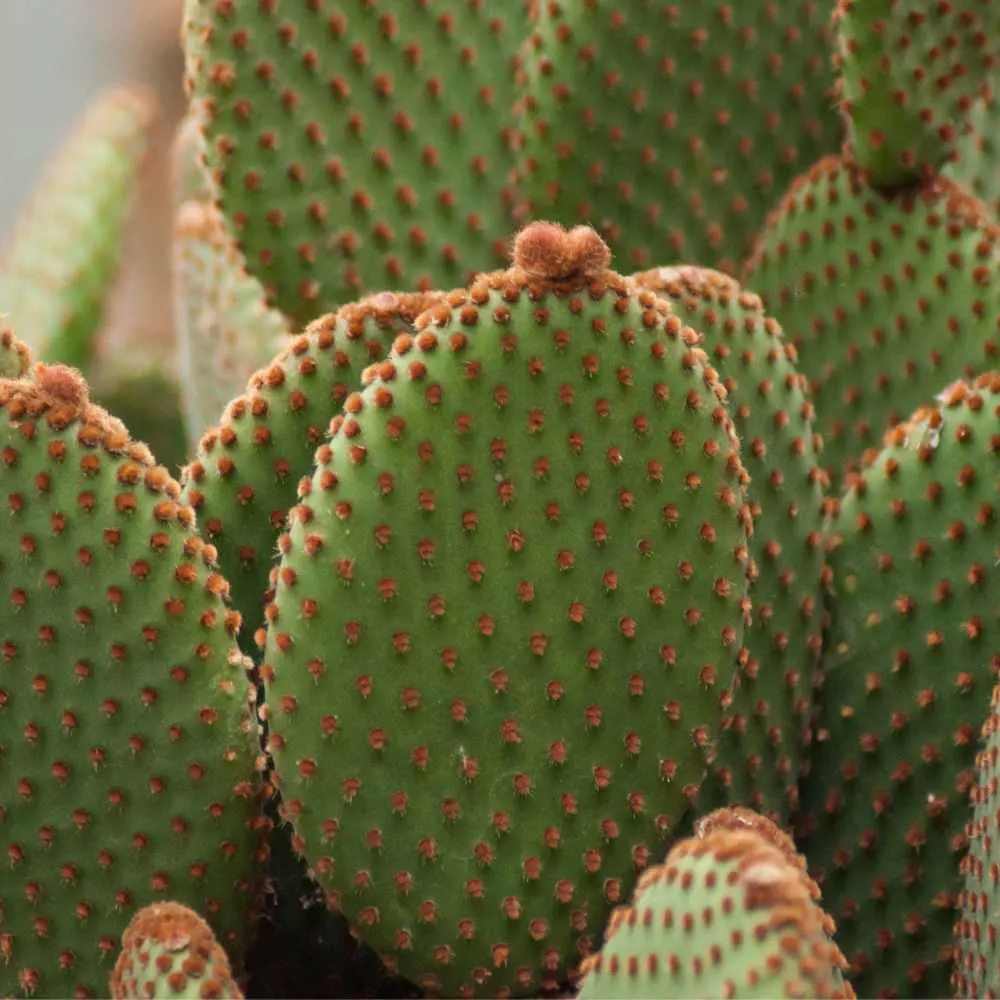
Since Prickly pears are a popular landscape plant, if you have a suitable climate for them plant your favorite Prickly pear cactus in your yard. but it may take awhile to get a large patch of cactus. On average, prickly pear cacti can only grow from 3 to 12 inches (7.5 to 30 cm) per year.
How to Make Prickly Pear Syrup Recipe:
To make prickly pear syrup we extract the juice from the fruits. Regardless of the variety and the tunas are boiled until soft and the pulp is blended, then strained to obtain the juice. This juice is then combined with water and sugar to create the syrup.
Which parts of the cacti are needed for syrup?
Fortunately, prickly pear cactus syrup only uses the fruits, also known as tunas, that grow from the cactus pads. Tunas grow on both spineless and spiny varieties of cactus in a myriad of colors and flavors. They may not be exactly easy to pick but at least you can get to them.
Harvest tunas when they are vibrantly colorful and plump. That means they are ripe. Colors range from yellow to orange or purple. Your syrup will be the same color as the fruits you pick. 🙂
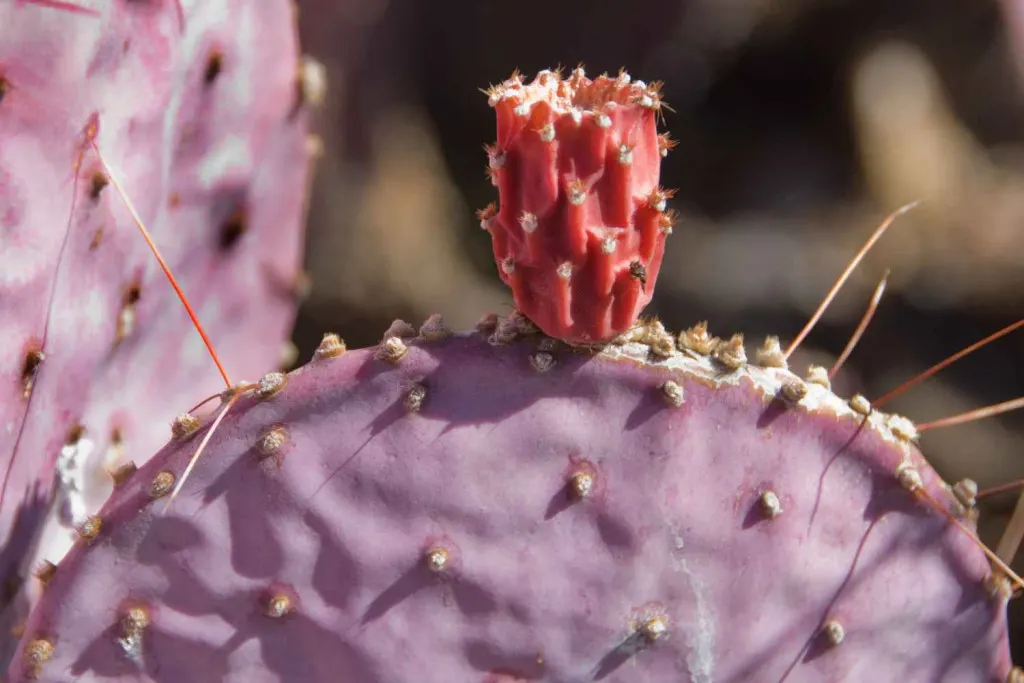
Prepping Tunas For Prickly Pear Syrup Recipe:
Handle the prickly pear fruits with care. You want to avoid contact with spines or glochids on either the cactus plant or the fruits themselves. Using tongs or gloves during the harvesting and preparation process is a really great idea.
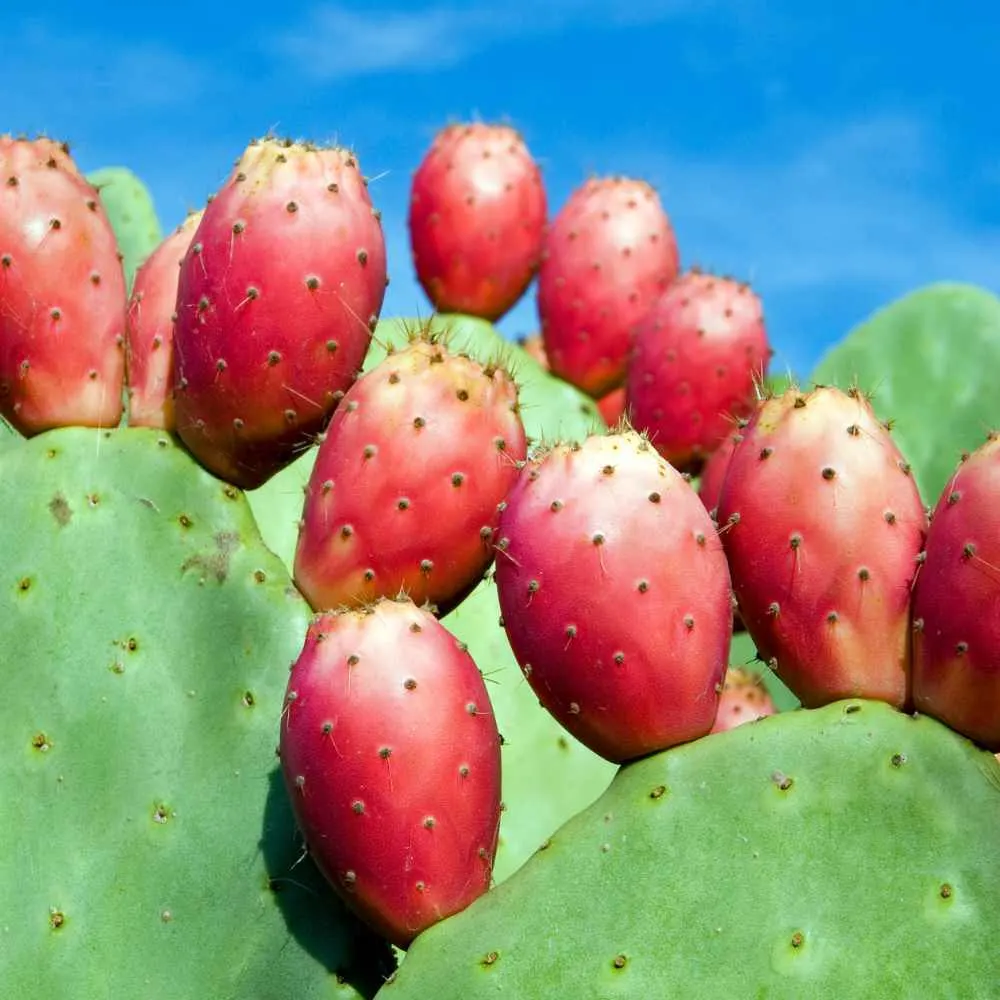
When harvesting, Choose ripe tunas. Look for vibrantly colored fruits that pull off the cactus plant easily. Respect the spikes and glochids on the fruits and pads to avoid puncture wounds. Use a pair of tongs and wear heavy leather gloves to pluck the tunas from the cactus. Avoid touching the spines as much as possible. Collect the tunas into a basket or bucket.
Careful removal: When removing spines or glochids, proceed with caution and use tools like a knife or vegetable peeler to scrape away the unwanted parts. Take your time and work slowly to minimize the risk of accidents. Or try carefully burning them off with a butane kitchen torch. Rinse off the charred parts of the fruit before boiling.
Cleaning tunas: Rinse the tunas under running water to remove any dirt or debris. Gently rub the surface of the tunas with your fingers or a soft brush to remove any loose spines or glochids. Take care not to press too hard and risk puncturing the skin.
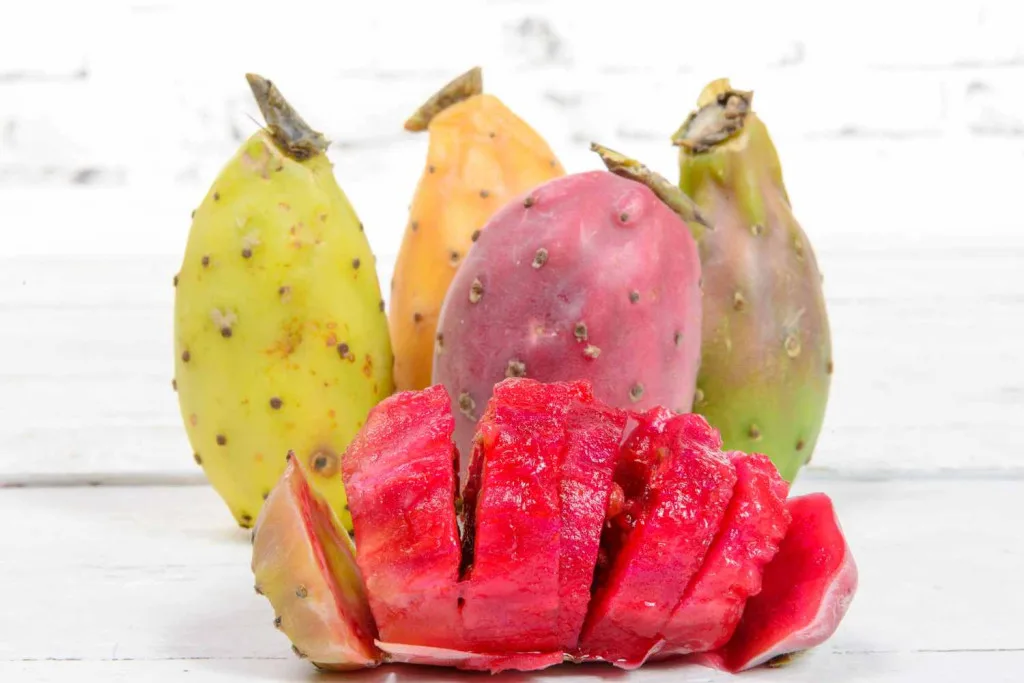
Prickly Pear Syrup Recipe- The Process:
The tunas can go into the boiling pot whole with spines and glochids or you can peel the fruits beforehand when they are raw and just add the pulp. By boiling the whole tunas, you extract the best of their natural flavors and vibrant colors. This creates the best, most delicious syrup.
- Boiling the tunas: Place the whole cleaned tunas in a large pot and add enough water to cover them. Bring the water to a boil and then reduce the heat to a simmer. Allow the tunas to simmer for about 20-30 minutes until they become soft and tender.
- Straining: After boiling the tunas until they become soft and tender, strain the mixture through a fine-mesh sieve or cheesecloth. This will separate the juice from any seeds, solids, or remaining spines/glochids.
- Extracting the juice: Depending on the consistency of the pulp, it may take anywhere from 30 minutes to a few hours for the majority of the juice to strain through. Gently tapping or lightly pressing the pulp against the sieve occasionally can help facilitate the process. the pulp against the sieve to extract as much juice as possible.
- Optional second straining: If you want a clearer juice or want to make sure you get every smaller particle out of the syrup, strain the extracted juice one more time through a clean fine-mesh sieve or cheesecloth. This additional straining catches any remaining solids or fine particles.
- Sweetening and simmering: Transfer the extracted juice back to the pot and add a sweetener of your choice, such as sugar, Agave or honey, to taste. Stir well to dissolve the sweetener. Return the pot to the stove and simmer the mixture over low heat, stirring occasionally, until it thickens to a syrup-like consistency.
- Cooling and storage: Remove the pot from the heat and let the syrup cool completely. Once cooled, transfer it to a clean, airtight container for storage in the refrigerator.
Does Prickly Pear Syrup Go Bad?
What is the shelf life of prickly pear syrup? When stored properly, the shelf life of this prickly pear syrup recipe is several months. Store the syrup in a sealed container in the refrigerator to maintain its freshness. Eventually the syrup will begin to degrade in quality, develop an off taste, or show signs of mold or fermentation. Check the syrup periodically for any signs of spoilage and discard it if it appears to have gone bad.
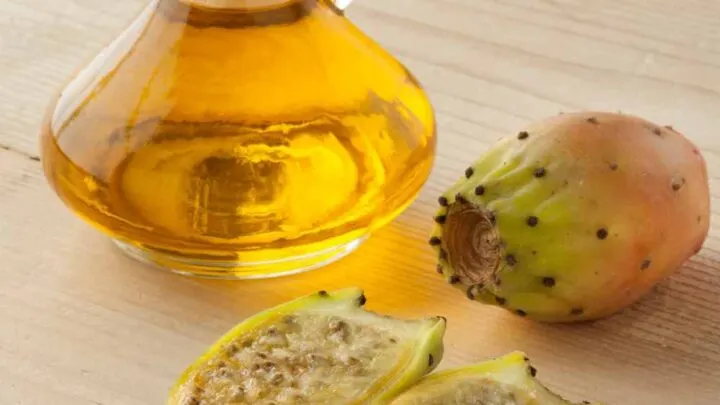
Prickly Pear Syrup Recipe
This simple recipe for prickly pear syrup will make the most out of your tunas and give you a deeply flavored, vibrantly colored prickly pear syrup. Boiling the tunas whole brings out the fullest flavor and captivating color. Blending the puree and cooking it down with sugar creates a velvety syrup that perfectly balances sweetness and the cactus fruit's unique essence.
Drizzle cactus syrup over pancakes, ice cream, desserts or use it in cocktails and other drinks.
Ingredients
- 4-6 ripe prickly pears (also known as tunas)
- 1 cup water
- 1 cup granulated sugar
- Juice of 1 lemon (optional, for flavor balance)
Instructions
- Prepping Prickly Pear Tunas: Remove the spines and glochids (tiny hair-like prickles) from the tunas before cooking with a stiff brush. Or scrape them off with a sharp knife or peeler. Use gloves to handle them. Leave the peels on. Rinse the tunas under cold water to remove any dirt or debris.
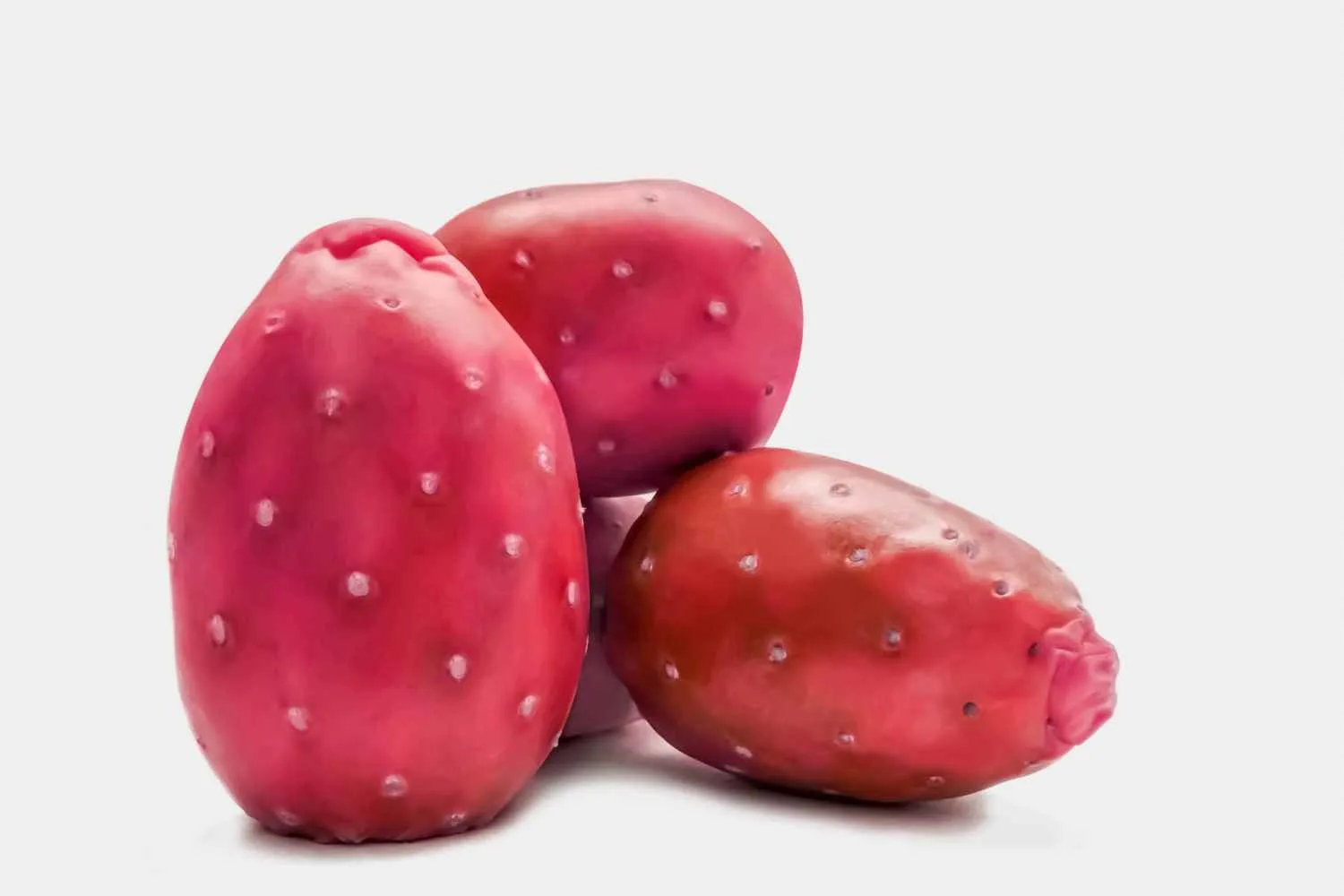
- Place the clean tunas in a large pot and add enough water to cover them. Bring the water to a boil over medium-high heat.
Once the water reaches a rolling boil, reduce the heat to medium-low and let the tunas simmer for about 20-30 minutes. This will help soften the fruit and release its flavors. - After simmering, carefully remove the tunas from the pot using tongs or a slotted spoon. Allow them to cool slightly.
- Once the tunas are cool enough to handle, cut off the ends and peel away the skin. You can use a knife to make a small incision and then peel off the skin, revealing the pulp inside.
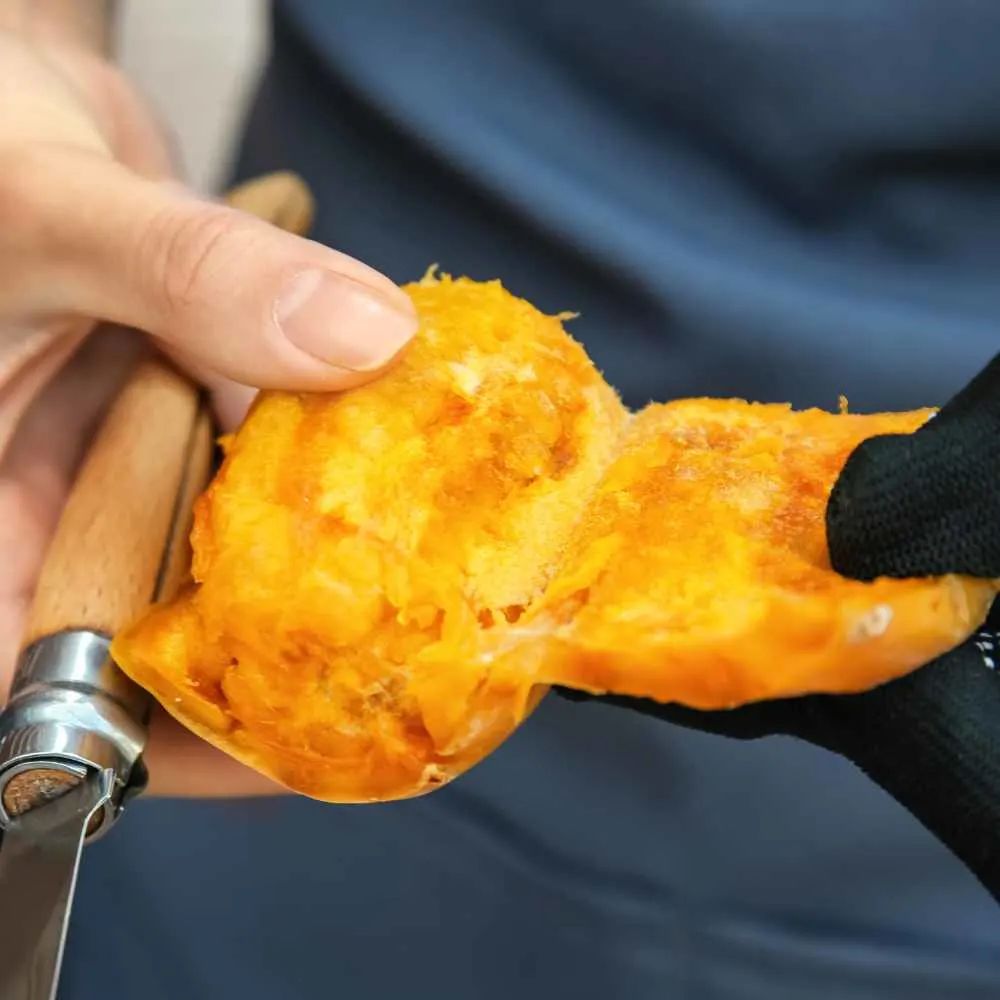
- Place the peeled tunas in a blender or food processor and blend until smooth. The resulting puree will form the base of your prickly pear syrup.
- Transfer the puree to a large saucepan and add sugar (usually in a 1:1 ratio with the puree, but you can adjust to your taste).
- Cook the mixture over medium heat, stirring occasionally, until the sugar has dissolved and the mixture has thickened into a syrup consistency.
- Once the syrup has thickened, remove it from the heat and let it cool. Strain the syrup through a fine-mesh sieve or cheesecloth to remove any remaining solids.
- Transfer the strained syrup to sterilized jars or bottles, and store them in the refrigerator for up to several weeks.
Notes
By boiling the tunas whole skin, you can extract the maximum flavor and color from the fruits, resulting in a rich and vibrant prickly pear syrup.
Nutrition Information
Yield
8Serving Size
1Amount Per Serving Calories 130Total Fat 0gSaturated Fat 0gTrans Fat 0gUnsaturated Fat 0gCholesterol 0mgSodium 5mgCarbohydrates 33gFiber 3gSugar 25gProtein 1g
Recipes to Use Prickly Pear Cactus Syrup:
There are SO many delicious ways to use your prickly pear simple syrup recipe. Here’s just a few ideas! Make our delicious Prickly pear Margarita, drizzle your cactus syrup over pancakes or even cheesecake. So many fantastic uses for your homemade cactus syrup. Yummy!
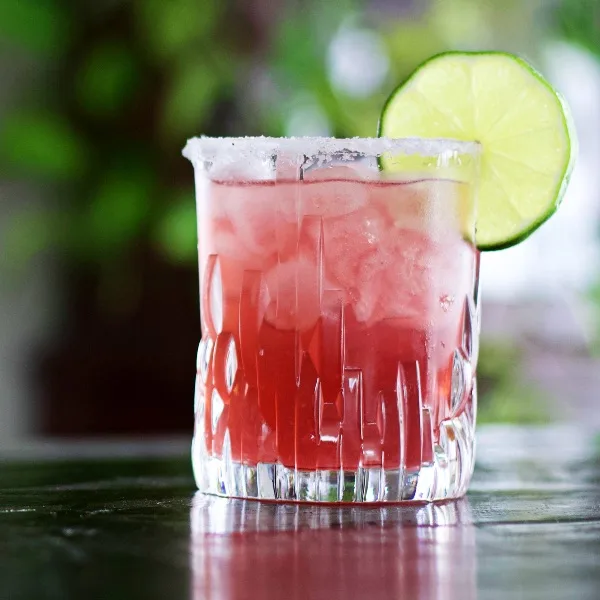
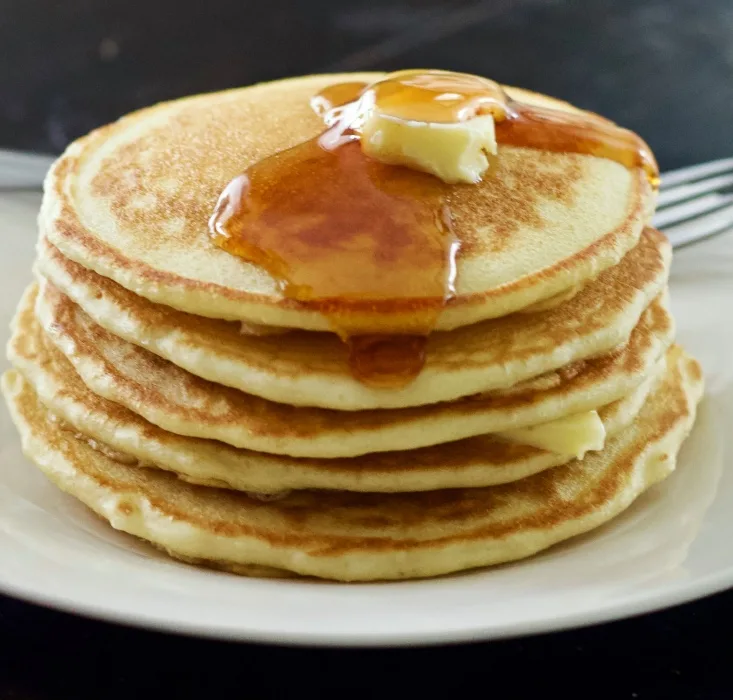
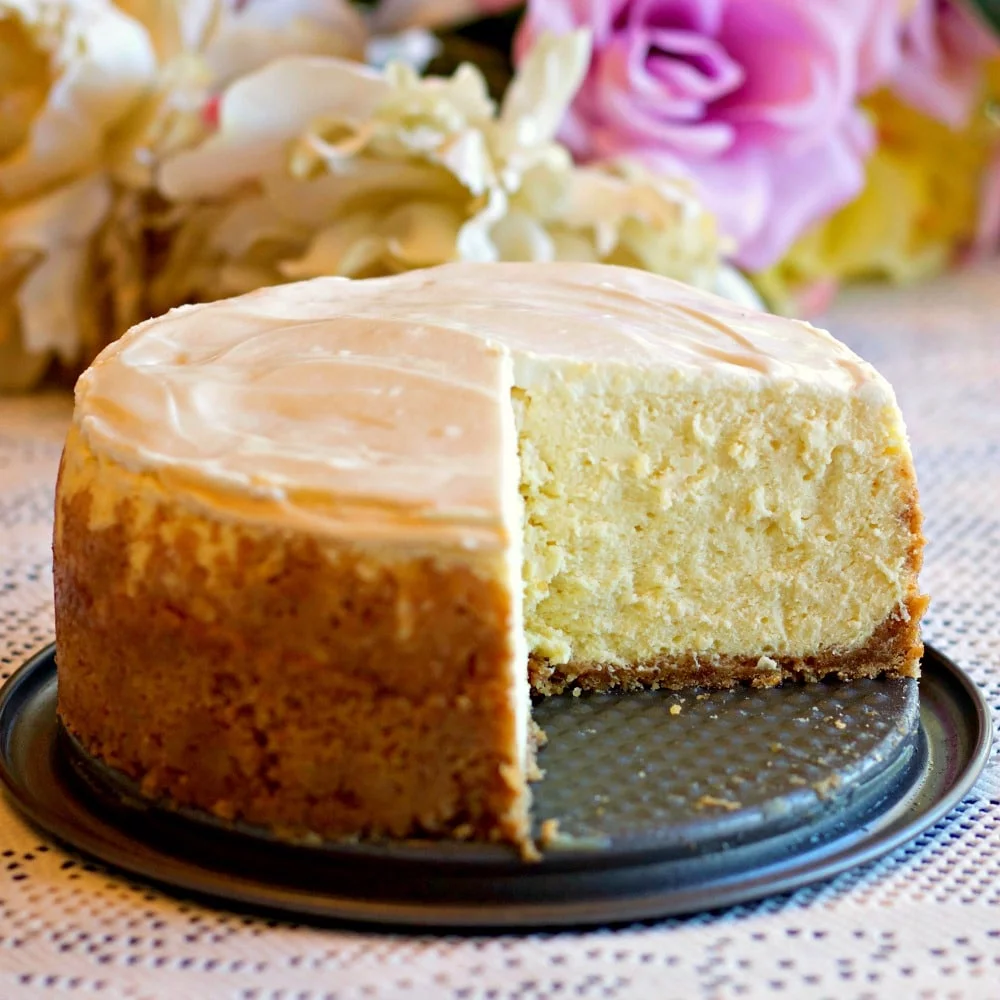
- Crispy Light Waffles
- Greek Yogurt Pancakes
- Vanilla Bean Ice Cream
- Buttermilk Pancakes
- crustless cheesecake
- Crepes
Follow Us:
We enjoy meeting you on our social networks. Follow us on Facebook, Pinterest, Instagram . Tag us with your pictures of our recipes and comment on how it went for you. We would love to see what you do with them.
We often like, comment and share your posts of our recipes on our daily Instagram stories.
Ask questions and rate the recipe in the comments section below. Please share what you did with this recipe. We are always looking for more and better ways to make homemade food. Other cooks love your ideas!
Recent Posts:
